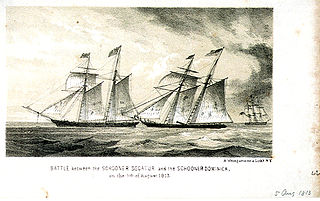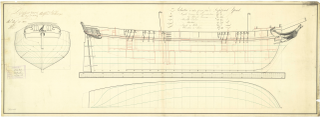
USS Wasp of the United States Navy was a sailing sloop-of-war captured by the British in the early months of the War of 1812. She was constructed in 1806 at the Washington Navy Yard, was commissioned sometime in 1807, Master Commandant John Smith in command. In 1812 she captured HMS Frolic, but was immediately herself captured. The British took her into service first as HMS Loup Cervier and then as HMS Peacock. She was lost, presumed foundered with all hands, in mid-1814.

HMS Fantome was an 18-gun brig-sloop of the Royal Navy. She was originally a French privateer brig named Fantôme, which the British captured in 1810 and commissioned into British service. Fantome saw extensive action in the War of 1812 until she was lost in a shipwreck at Prospect, Nova Scotia, near Halifax in 1814.

Astrée was a 44-gun Pallas-class frigate of the French Navy, launched at Cherbourg in 1809. In December of the next year she captured HMS Africaine. The Royal Navy captured Astrée in 1810 and took her into service under her French name, rating her as a 38-gun frigate, but then in 1811 recommissioned her as HMS Pomone. She served during the War of 1812 and was broken up in 1816.

HMS Belette was an 18-gun Cruizer-class brig-sloop, built by King at Dover and launched on 21 March 1806. During the Napoleonic Wars she served with some success in the Baltic and the Caribbean. Belette was lost in the Kattegat in 1812 when she hit a rock off Læsø.

HMS Crane was a Royal Navy Cruizer-class brig-sloop launched in 1809. She had an unusually uneventful five-year career before she foundered in 1814.
During the period of the Napoleonic Wars, two vessels have served the British Royal Navy as His Majesty's Hired armed cutter Idas, named for Idas, a figure from Greek mythology.
HMS Nemesis was a 28-gun Enterprise-class sixth-rate frigate of the Royal Navy. The French captured her in 1795 at Smyrna, but in 1796 a squadron led by Barfleur brought her out of the neutral port of Tunis. Throughout her career she served under a number of commanders who would go on to have distinguished careers. She was converted to a troopship in 1812 and was sold in 1814.

HMS Dominica was the French letter of marque schooner Duc de Wagram, which the British captured in 1809 in the Leeward Islands and took into the Royal Navy in 1810. The American privateer Decatur captured her in 1813 in a notable single-ship action. However, Majestic recaptured her in 1814. She was wrecked in 1815
HMS Linnet was originally His Majesty’s revenue cutter Speedwell, launched in 1797, that the Royal Navy purchased in 1806. Linnet captured a number of privateers before the French frigate Gloire captured her in 1813. The French sold or transferred her to the Americans, who operated her as the privateer Bunkers Hill. In March 1814 the British recaptured her, but did not return her to service.
HMS Netley was launched in 1798 to an experimental design. During the French Revolutionary Wars she spent some years on the Oporto station, where she captured many small privateers. The French captured her in 1806, early in the Napoleonic Wars. They lengthened her and she became the 17-gun privateer Duquesne. In 1807 the British recaptured her and the Royal Navy returned her to service as the 12-gun gun-brig HMS Unique. She was expended in an unsuccessful fire ship attack at Guadeloupe in 1809.

HMS Minorca was a Cruizer-class brig-sloop of the Royal Navy, launched in 1805. She served during the Napoleonic Wars in the Mediterranean and was broken up after an uneventful career.
HMS Gleaner was the mercantile ketch Gleaner, launched in 1802. She served the Royal Navy as the "hired ketch Gleaner" from 12 July 1808 until the Navy purchased her in 1809. Initially she served as a light vessel and survey vessel. From early 1811 to August 1811 she served in the Mediterranean, where she captured an Ottoman vessel. She then became a yard lighter and a light vessel again. Then in 1812 she was on the North American station where she participated in the capture of several merchant vessels. Next she returned to the Mediterranean where she captured a privateer. Finally, she served off the north coast of Spain where she was wrecked on 2 March 1814.
HMS Vautour was 16-gun brig-sloop of the British Royal Navy. The navy captured her from the French on the stocks in 1809 and commissioned her in 1810. She foundered in October 1813.
HMS Elizabeth was a French privateer schooner that the Royal Navy captured in 1805 and took into service under her existing name. She participated in an engagement and a campaign that earned her crews clasps to the Naval General Service Medal. She was lost with all hands in 1814 when she capsized in the West Indies.
HMS Foxhound was the French Navy's brig Basque, launched in 1809, that the British Royal Navy captured in 1809 and took into service as a 16-gun sloop. She had a relatively brief naval career in which she captured a number of merchant vessels. After the Navy sold her in 1816, she made some 10 or 11 whaling voyages between 1817 and 1848.

HMS Wanderer was a Cormorant-class ship-sloop launched in 1806 for the Royal Navy. The Royal Navy sold her in 1817. She made one voyage between 1817 and 1820 as a whaler. She then sailed between Plymouth and North America until October 1827 when her crew had to abandon her at sea because she was waterlogged.
HMS Plumper was launched in 1807. She captured three small American privateers early in the War of 1812 but was wrecked in December 1812.
HM hired armed cutter Flora served the British Royal Navy under contract from 16 August 1794 until a French privateer captured her on 1 December 1798.
HMS Decoy was launched in 1810. She participated in the capture of several small French privateers, captured or recaptured a number of merchant vessels, and captured a number of smuggling vessels. The French captured her in 1814.

Milan was a French brig built at Saint Malo, from plans designed by François Pestel that had already served for Curieux in 1800 and for Palinure in 1804. She served in the French Navy for four years before HMS Surveillante and Seine captured her. She became HMS Achates in the Royal Navy and served until after the end of the Napoleonic Wars.







